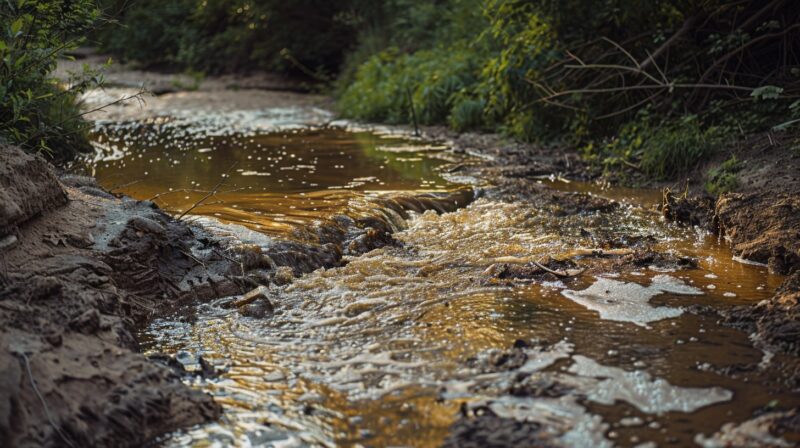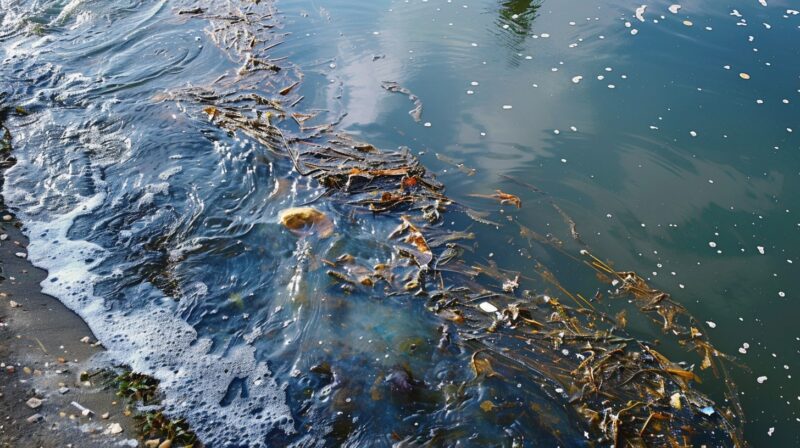Sediment Pollution Policies can play a crucial role in protecting our environment and communities, though this issue is often overshadowed by other environmental concerns. Sediment pollution involves the accumulation of particles like soil, sand, and minerals in water bodies, leading to habitat alteration, reduced water quality, and harm to aquatic life.
Despite the severe impacts of sediment pollution, it is frequently neglected in many environmental protection efforts.
This problem seriously threatens ecosystems and human health, yet it often doesn’t receive the attention it deserves. The buildup of sediment can alter aquatic habitats, reduce water quality, and harm the plants and animals living in these environments. To address sediment pollution, we need to prioritize the development and implementation of effective policies.
What is Sediment Pollution?
Sediment pollution occurs when soil particles and other materials are washed into water bodies. This can result from natural processes like erosion or human activities such as construction, agriculture, and deforestation.
When these particles enter rivers, lakes, and oceans, they cloud the water, reducing light penetration and affecting the photosynthesis of aquatic plants.
Sediments can also carry pollutants, including heavy metals and pesticides, which further degrade water quality and pose health risks to wildlife and humans. According to the Mid-America Regional Council, deposition can fill up storm drains, increase flooding potential, and disrupt aquatic habitats by making water murky and unsuitable for plant and animal life.
Interesting fact: Sediment pollution causes $16 billion in environmental damage annually

Sources
- Construction sites leave soil exposed, leading to erosion and runoff
- Agricultural practices, especially tilling, that disturb the soil and increase erosion
- Deforestation, which removes vegetation that holds soil in place, resulting in soil loss and sedimentation
- Urban stormwater runoff carrying sediments and other pollutants from streets and industrial sites into water systems
Impacts on Aquatic Life
Water pollution with feces harshly affects aquatic ecosystems. The increased turbidity, or cloudiness, of water, reduces the amount of sunlight that can penetrate, impairing the growth of photosynthetic plants and algae.
These organisms form the base of the aquatic food web, so their decline can ripple through the entire ecosystem. Sediments can also smother fish eggs and benthic organisms, which live on the bottom of water bodies. Furthermore, pollutants attached to sediment particles can be toxic to fish and other aquatic animals, leading to health problems and population declines.
Human Health Concerns
Deposit pollution is not just an environmental issue; it poses significant risks to human health. Pollutants attached to sediment particles can contaminate drinking water sources, leading to serious health issues. For example, heavy metals like lead and mercury can cause neurological and developmental problems, especially in children.
Pesticides and other chemicals can lead to various health problems, including cancer and endocrine disruption. Sediment-laden water can clog water treatment facilities, making providing safe drinking more challenging and expensive.
Read more: Find out HERE why water conservation should be a global priority.
Economic Consequences
The economic impact of sediment pollution is substantial. It increases the cost of water treatment, as more effort is needed to remove sediments and associated pollutants. Deposition accumulation in water bodies can necessitate costly dredging operations to maintain navigable waterways for shipping and recreational activities.
It can harm industries that rely on clean water, such as fisheries and tourism. The loss of biodiversity and the degradation of natural habitats can have long-term economic repercussions for communities that depend on these resources.
Solutions and Mitigation Strategies

Addressing sediment pollution requires regulatory measures and practical solutions.
- Implementing best management practices (BMPs) in agriculture, such as contour farming and maintaining vegetative buffer strips, to reduce soil erosion and sediment runoff (soil erosion can lead to thermal pollution which is very dangerous for aquatic life)
- Using erosion control measures like silt fences and sediment basins at construction sites to prevent soil from washing into waterways
- Reforestation and restoring natural vegetation to help stabilize the soil and reduce sedimentation
- Improving stormwater management systems in urban areas to capture and treat runoff before it reaches water bodies
Additional strategies:
- Sweeping sidewalks and driveways instead of hosing them off, as washing these areas results in sediment and other pollutants running off into water bodies
- Use weed-free mulch when reseeding bare spots on your lawn, and use a straw erosion control blanket if restarting or tilling a lawn
- Notifying local government officials when you see sediment entering streets or streams near a construction site
- Applying compost or weed-free mulch on your garden to help keep soil from washing away
- Avoiding mowing within 10 to 25 feet from the edge of a stream or creek to create a buffer zone that will help minimize erosion and filter stormwater runoff
- Washing your car at a commercial car wash or on a surface that absorbs water, such as grass or gravel
Advanced Remediation Technologies
Effective remediation of sediment pollution often involves advanced technologies. Techniques such as chemical stabilization, phytoremediation, and bioremediation have shown promise in treating contaminated soils and sediments. Chemical stabilization involves adding materials that reduce the mobility of contaminants, making them less likely to enter water systems.
Phytoremediation uses plants to absorb and accumulate pollutants, while bioremediation employs microorganisms to break down hazardous substances. These methods can be combined with traditional approaches to enhance their effectiveness and sustainability.
Recent advancements in these technologies have shown increased efficiency and cost-effectiveness, making them viable options for large-scale applications.
Policy Recommendations
Effective environmental policies must include specific provisions for controlling sediment pollution. Regulations should require industries and developers to implement BMPs that minimize soil disturbance and manage stormwater runoff. Agricultural policies should promote sustainable farming practices that reduce erosion and maintain soil health.
Public awareness campaigns can educate communities about the importance of preventing and the steps they can take to reduce their impact. Increased funding for research and monitoring can help identify the most effective strategies for managing sediment pollution and protecting water quality.
Policies should mandate regular inspections and compliance checks to ensure adherence to BMPs. Incentives for adopting green infrastructure and sustainable practices can also motivate stakeholders to reduce sediment pollution.
Conclusion
Sediment pollution is a big problem for our environment, aquatic life, and human health, but it often doesn’t get the attention it deserves. When soil and other particles wash into water bodies, they can ruin habitats, lower water quality, and spread dangerous pollutants.
We need to take this issue seriously and create strong policies to address it. By using better practices in farming, construction, and city planning, and by using advanced cleaning technologies, we can reduce sediment pollution. It’s important to raise public awareness and enforce stricter rules to protect our natural resources and ensure a healthier future for everyone.

